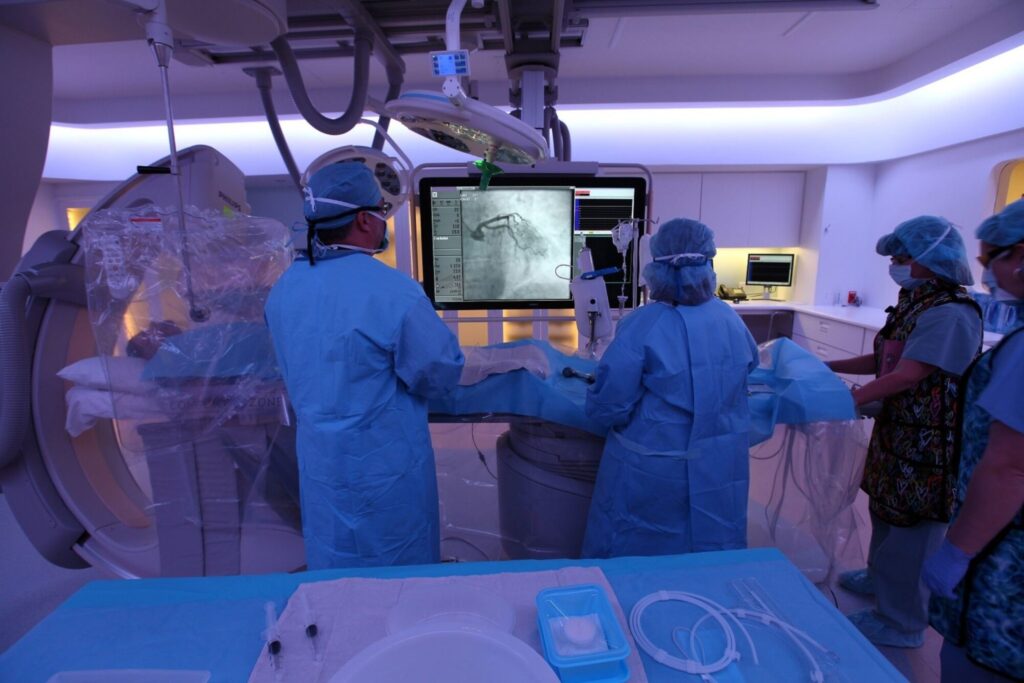Heart and Vascular
Cardiology Center
We recognize that timely care is critical when it comes to cardiovascular health. That’s why our inclusive cardiology center features two state-of-the-art interventional labs and a comprehensive suite of cardiac diagnostic tools. Our newly added cardiac catheterization labs offer advanced diagnostic and interventional cardiology services, including diagnostic heart catheterization, interventional catheterization, EP device implants, and more.
Advanced Diagnostic Care For Your Heart
It is comforting to know that advanced cardiovascular care is just a heartbeat away at Baylor Scott & White Surgical Hospital at Sherman. Current techniques and technologies enable us to provide patients with advanced cardiac diagnostics and coronary and peripheral interventions.
Common heart condition symptoms and treatment options:
Whether you’ve started experiencing symptoms such as shortness of breath, heart palpitations or weakness or have lived with them for a while, it’s a good time check in with your heart health. Our resources help you know the signs, risk factors and treatment options.



Our Services:
Baylor Scott & White Surgical Hospital at Sherman offers a comprehensive cardiovascular program that covers everything from minimally invasive procedures to interventional radiology.
Our experienced team of board-certified cardiologists on the medical staff and highly trained surgeons, nurses, diagnosticians and clinicians is here to provide the high level of cardiovascular care you expect and deserve. Some of our services include:
Diagnostic Services:
- Diagnostic Left Heart Catheterization
- Diagnostic Right Heart Catheterization
- Diagnostic Peripheral Venogram
- Diagnostic Peripheral Arteriogram
- Transesophageal Echocardiogram
Interventional Services:
- Interventional Left Heart Catheterization with Percutaneous Coronary Intervention
- Interventional Left Heart Catheterization with Angioplasty
- Interventional Venography with Angioplasty and stenting
- Interventional Arteriogram with Angioplasty and stenting
- Inferior Vena Cava (IVC) Filter Placement and Removal
Electrophysiology Services:
- Direct Current Cardioversion
- Implantable Loop Recorder (ILR) implantation
- Implantable Loop Recorder (ILR) extraction
- Single Chamber Permanent Pacemaker Generator Change
- Single Chamber Permanent Pacemaker Implantation
- Dual Chamber Permanent Pacemaker Generator Change
- Dual Chamber Permanent Pacemaker Implantation
- Single Chamber Implantable Cardioverter Defibrillator Generator Change
- Single Chamber Implantable Cardioverter Defibrillator Implantation
- Dual Chamber Implantable Cardioverter Defibrillator Generator Change
- Dual Chamber Implantable Cardioverter Defibrillator Implantation
- Biventricular Implantable Cardioverter Defibrillator Generator Change
- Biventricular Implantable Cardioverter Defibrillator Implantation
Modern cardiology is shifting towards precise, personalized, and non-invasive diagnostics. The powerful combination of coronary computed tomography (CCTA), plaque analysis, and fractional flow reserve (FFR) offers a comprehensive view of heart disease.
Coronary Computed Tomography Angiography (CCTA)
The CCTA procedure generates a comprehensive anatomical view of the coronary vasculature. This allows for the rapid and effective detection of coronary artery disease (CAD) by identifying the location and extent of atherosclerotic plaque and the resulting arterial narrowing (stenosis).
However, CCTA alone cannot definitively determine the hemodynamic significance of a blockage. This is where the other two diagnostic components become essential
Plaque Analysis
For a long time, doctors primarily focused on the degree of narrowing in an artery. But we now know that not all plaque is created equal. Plaque analysis, which is done by advanced software on the CCTA images, looks at the composition and volume of the plaque.
This analysis provides crucial information:
- Plaque Types: It differentiates between different types of plaque, such as calcified (hard) and non-calcified (soft) plaque. Soft, non-calcified plaque is often considered more dangerous because it’s more likely to rupture, which can trigger a blood clot and cause a heart attack.
- Total Plaque Burden: It measures the total volume of plaque throughout the coronary arteries, giving a more complete picture of the disease.
- Vulnerable Plaque: It can identify characteristics of “vulnerable” or high-risk plaque, which may not be causing a severe blockage yet but could pose a risk for a future cardiac event.
Plaque analysis shifts the focus from just “Is there a blockage?” to “What’s the overall health of the artery walls, and is there a hidden danger?”
Fractional Flow Reserve (FFR)
Traditionally, Fractional Flow Reserve (FFR) was an invasive procedure done in a catheterization lab. It involves threading a special wire into a coronary artery to measure the blood pressure both before and after a blockage. The ratio of those two pressures tells you how much the blockage is actually restricting blood flow to the heart muscle. An FFR value of 0.80 or lower is typically considered a sign that the blockage is significant and may require intervention, like a stent.
The most transformative development is CCTA-derived Fractional Flow Reserve (FFR-CT). This non-invasive technology employs computational analysis and artificial intelligence (AI) to create a detailed simulation of blood flow based on CCTA data. It accurately quantifies FFR throughout the coronary tree, circumventing the need for an invasive procedure.
Putting It All Together
When used together, CCTA, plaque analysis, and FFR-CT provide a powerful, non-invasive diagnostic solution:
- A CCTA is performed to get the initial “road map.”
- Plaque analysis is applied to the CCTA images to evaluate the total plaque burden and identify high-risk features.
- FFR-CT is then calculated from the same CCTA images to determine the physiological impact of any blockages.
This combined method allows doctors to determine the size and nature of a blockage and assess whether it is severely limiting blood flow to the heart muscle. This helps guide treatment, avoid unnecessary invasive procedures, and create a more personalized risk assessment.

Baylor Scott & White Surgical Hospital at Sherman complies with applicable Federal civil rights laws and does not discriminate on the basis of race, color, national origin, age, disability, or sex. Baylor Scott & White Surgical Hospital at Sherman is a facility in which physicians have an ownership or investment interest. The list of physician owners or investors is available to you upon request. ©2021 Baylor Scott & White Health 99-ALL-385673 KDP
